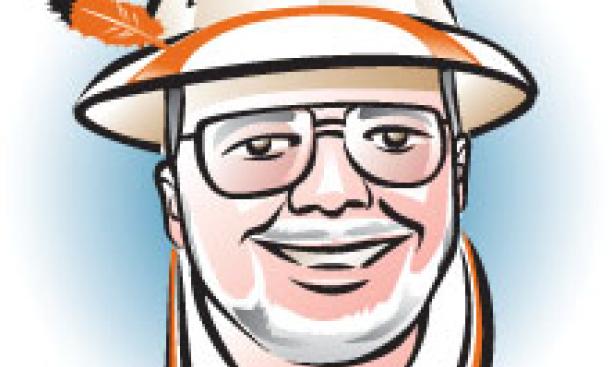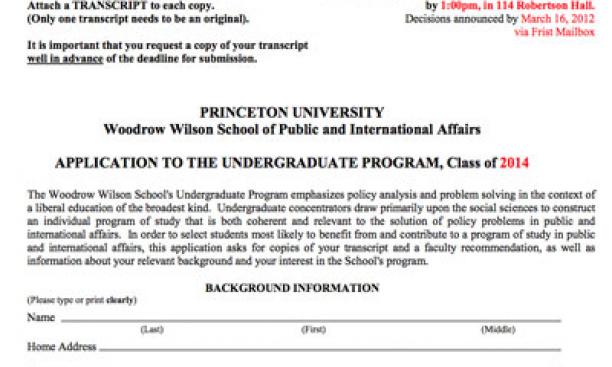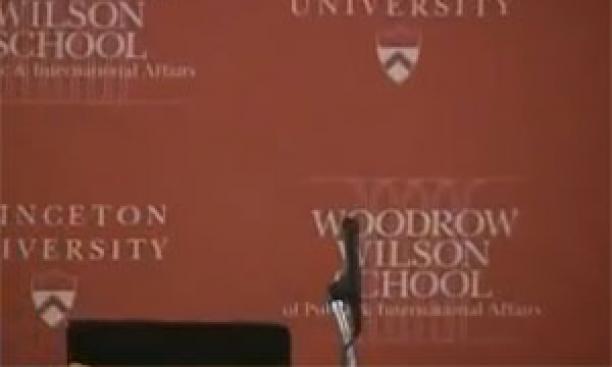
“Each place of assembly has a maximum occupancy limit that must not be exceeded at any time. The limit is determined by a number of factors including the floor space, intended use of the space (e.g., will tables and chairs be provided or will everyone be expected to stand), and the availability and capacity of exits.”
- University Health and Safety Guide

There are plenty of things in life that just, well … are. If we spent our time considering them on a conscious level, we’d go bonkers. The Brits driving on the left side of the road, for example – well, OK, they think it’s the right side, but anyway – goes back to medieval lances or something. The engine in front of the car where it can fry us to a crisp all summer is because, uh … Or in the immortal words of the monumental 20th-century logician, Bob Newhart: “Ninety feet between bases? Why 90 feet, Mr. Doubleday?”
Which leads us to the brave pioneers of the Woodrow Wilson School of Public and International Affairs, the first such animal anywhere in the nation at its outset, who have been perpetrating selective refinement upon the undergraduate body of the University for lo these many decades because, uh … well … they could?
Since we here at History Central normally are celebrating things that happened some number of decades or centuries ago, it’s sort of fun to discuss an event that’s going to take place a year from now, when those nice future donors from the Class of 2015 hitch their stars to the departments in which they’ll spend their junior and senior years learning how to think, and most importantly – as any alumnus can tell you without hesitation – write their theses. The really notable thing that will happen in the Wilson School is: nothing at all, for a change. That’s the occasion; a trip in the Wayback Machine will explain, partly.
The School of Public and International Affairs (SPIA) was founded in 1930, a new idea in practical education in public service honoring the late president/President Woodrow Wilson 1879, whose “Princeton in the Nation’s Service” address at the 1896 University Sesquicentennial had been rendered even more poignant through the collapse of his idealistic Fourteen Points and his subsequent demise from sheer exhaustion after the punitive Treaty of Versailles. Spearheaded by visionary trustees William Church Osborn 1883 and Albert Milbank 1896 and faculty committee chairman Harold Dodds *1914 of the politics department, the certificate program – pointedly called a “school” from the outset – sought to train and inspire potential government and public-sector talent at the undergraduate level; as formulated by the combined faculty of the economics, history, and politics departments, it was popular from day one. The 42 students who immediately signed up for the program spread the word of the school’s conference courses and applied-research programs, and it rapidly gathered both student and faculty adherents. By 1939, with Dodds now University president and Dana Gardner Munro having taken the SPIA reins, it became a full-scale department, with its own senior exams and concentration requirements. And most tellingly, it was so popular among the undergraduates that it already required a formal application to be admitted, and limited its enrollment to 50 students per class. No one, apparently, thought this odd or restrictive, although it was unique at Princeton. Although nowadays enlarged to 90 admits annually, it remained from the early 1930s until Feb. 21, 2012, the only department on campus to turn away students who have fulfilled its prerequisite requirements, in this year’s case 45 percent of them.

Now the Wilson School (formally renamed in 1948) is indeed a complicated place, with many of the faculty holding joint appointments in other departments, even including psychology and sociology, and many customized public-affairs research centers and conferences as well as unique projects for real public-sector clients. It strongly encourages juniors to spend a semester abroad and builds that into its teaching. Its quality is unarguable, with faculty constantly involved in public discussion of strategic questions; its most recent two deans have gone on to become the U.S. State Department policy-planning director and the president of Brown. Somehow we were tacitly meant to believe that this set of differentiating elements justified a special standing beyond being labeled a school, which in itself doesn’t really mean a lot in a University with a single faculty and a single tenure committee. There’s that nagging little Yamasaki-façade logo along with the Princeton seal on the school’s special step-and-repeat backdrop (the word-covered curtain PR thingee) that annoys you behind the WWS talking heads on the news. But most especially, there’s the admission requirement. Any of us Alumni Schools Committee interviewers can assure you that the kids who are getting into Princeton these days are all perfectly capable of attacking any public-affairs seminar with gusto; even most of those turned away by the admission office are, too. The experimental SPIA structural challenges and economic constraints of the 1930s that may well have generated caution in growing the school quickly would seem to be long gone in any objective sense. So why has the cap on departmental majors remained?

Last fall, the school – to its great credit, I would say – essentially replied, “No good reason at all.” With a one-year delay to allow a stiffened set of prerequisite studies to be fulfilled by rising juniors, the cap will be gone a year from now and the Wilson School will be open to all qualified comers, like the engineering school, the architecture school, and every other blessed department on campus. And I won’t need to say to some high school valedictorian chess champion with 2400 SATs who wants to go into public service, “Of course, in two years you’ll need to apply to the Wilson School …”
And while all of this historically is quite interesting and a move in the right direction (eliminating the need for 180 faculty members each year to write recommendations to another on-campus department is a step forward in efficiency by itself), that’s not what has been nagging at me since the announcement. I’ve been wondering instead why we put up with this for so long.
Did limited sections lead to better results? Objective measures like major post-grad scholarships wouldn’t seem to indicate that. Was the model so complex that it was difficult to expand? No more than mol bio or physics, certainly. Maybe the perceived exclusivity (recall the separate logo and PR thing) carried along a sense of entitlement? Perhaps, but not enough to turn people away.
And why wasn’t this seen as inequitable? We fought like hell for fairness and equity (and sometimes just to fight) in the ’60s, but oddly I can’t recall anybody ever griping about the cap at Woody Woo. Students just fell in line without a word. Meanwhile, bicker, which is possibly more bizarre but no more arbitrary, gets derided from all sides all the time. I’m afraid a significant chunk of the real answer comes down to good ol’ inertia (from the Latin: “lack of skill”): The guys with the tweeds and pipes in the 1930s did it, so I guess we’ll do it, too. It’s always been 90 feet, according to Mr. Doubleday.
With the school administrators gamely pledging to take all applicants and somehow make it work next year, The Prince has theorized that the 164 who ran the gauntlet for the 90 spots this year will swell to more than 200 next year. I really doubt that. The Type-A students who perhaps should have been in poli sci or econ all along now may be more prone to take these studies on their merits, rather than reflexively try for an SPIA spot because it’s a challenge, or so they can say “I’m in Woody Woo and you’re not.” (Fortunately, we all know that adults outgrow such childish tendencies. Right?)
And anyway, it should be the faculty’s job in such a unique and outrageously gifted a place as Princeton to challenge the students to the complete extent that they can take it. The computer science, East Asian studies, and math departments have had to do that over the years, decades, and centuries, and it’s hard to believe that the brilliant SPIA folks with the prizes and fancy special Yamasaki backdrops can’t rise to the occasion, too. Wilson, in his 1896 speech, noted his own vision:
I have had sight of the perfect place of learning in my thought: a free place, and a various, where no man could be and not know with how great a destiny knowledge had come into the world.
That sounds quite like the once and future Woodrow Wilson School of Public and International Affairs. Godspeed to them.
